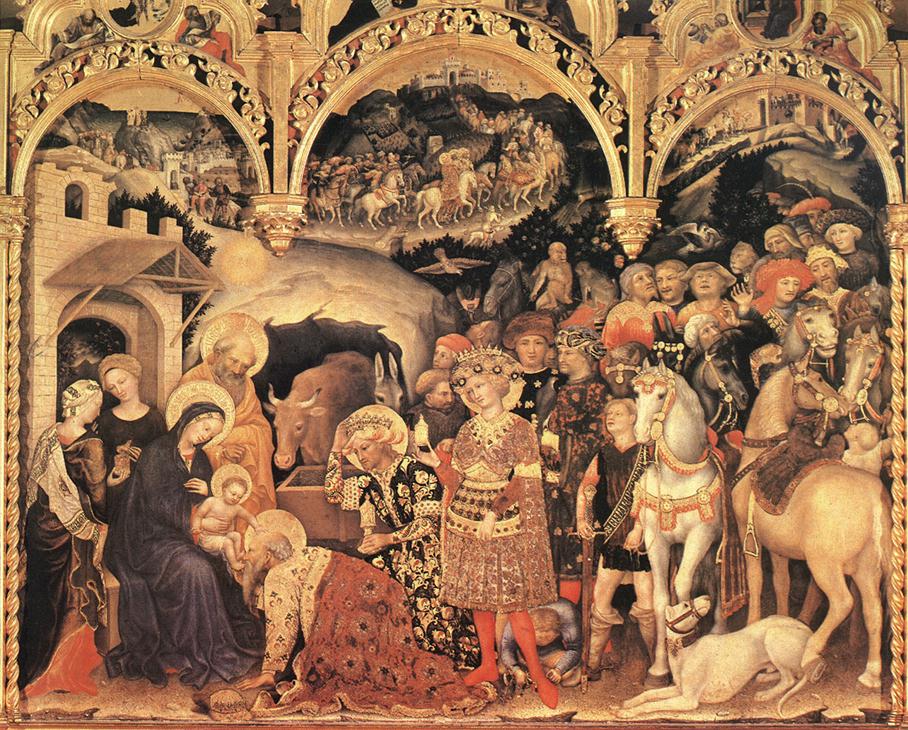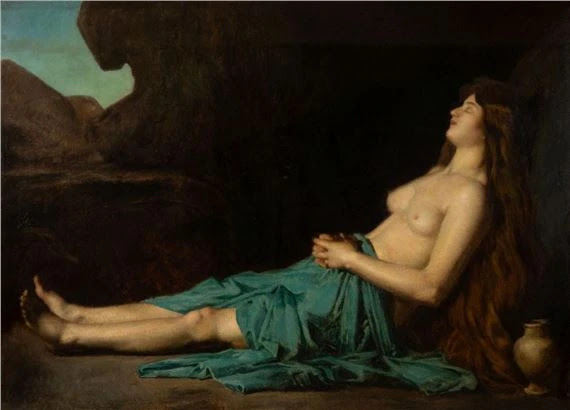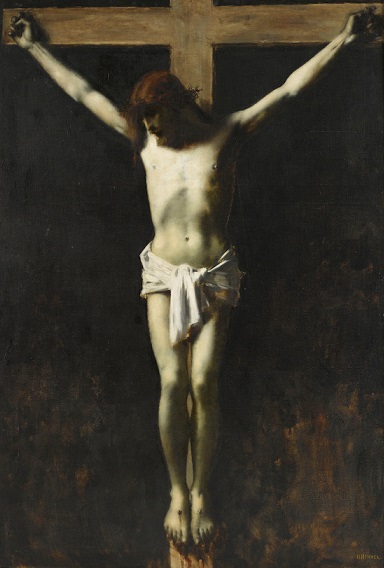Old Testament, Judges 11: 29 Now the Spirit of the LORD came upon Jephthah, so that he passed through Gilead and Manasseh; then he passed through Mizpah of Gilead, and from Mizpah of Gilead he went on to the sons of Ammon. 30 Jephthah made a vow to the LORD and said, "If You will indeed give the sons of Ammon into my hand, 31 then it shall be that whatever comes out of the doors of my house to meet me when I return in peace from the sons of Ammon, it shall be the LORD'S, and I will offer it up as a burnt offering."…
Pieter Lisaert ( Antwerp , 1574-1630) was a Flemish painter, specializing in historical, religious and allegorical painting matter.
A member of a family of artists and art dealers, his paintings, which are observed archaic features a mannerism, reveals influences of Frans Francken the Elder .
The little known Pieter Lisaert works. He hrepeated several times the parable of the foolish virgins and wise virgins ( Matthew 25: 1-13 ) (see below). More
Pieter Lisaert III (1574 - circa 1630)
The Parable of the Wise and Foolish Virgins
Medium oil on panel
73.4 × 104.8 cm (28.9 × 41.3 in)
The Parable of the Ten Virgins, also known as the Parable of the Wise and Foolish Virgins, is one of the well known parables of Jesus. It appears in two versions one in the Canonical gospels of the New Testament and one in the Epistula Apostolorum. According to the Gospel of Matthew 25:1-13, the five virgins who are prepared for the bridegroom's arrival are rewarded, while the five who are not prepared are disowned. The parable has a clear eschatological theme: be prepared for the Day of Judgment. It was one of the most popular parables in the Middle Ages, with enormous influence on Gothic art, sculpture and the architecture of German and French cathedrals. More
Giovanni Battista Tiepolo (1696–1770
Pope St Clement Adoring the Trinity, c. 1737 and 1738
Oil on canvas
Height: 488 cm (192.1 in). Width: 256 cm (100.8 in).
Alte Pinakothek, München, Germany
The painting shows Pope Clement I at prayer, in an ecclesiastical architectural setting which cannot be identified more closely, before a vision of the Holy Trinity. The lively facial expressions suggest a conversation between Clement and God the Father, which is further dramatized by the strong chiaroscuro contrasts. In an allusion to the particular connection between the donor and his famous patron saint, Tiepolo lends the portrait of the Pope a private character: the tiara and crosier, symbols of his power, have been laid aside and placed in the keeping of a putto. More
Pope Clement I (died 99), also known as Saint Clement of Rome, is listed Bishop of Rome, holding office from 88 to his death in 99. He is considered to be the first Apostolic Father of the Church.
Clement was consecrated by Saint Peter, and he is known to have been a leading member of the church in Rome in the late 1st century. Early church lists place him as the second or third bishop of Rome after Saint Peter.
Clement asserted the authority of the presbyters as rulers of the church on the ground that the Apostles had appointed such. In the legendary Clementine Literature, Clement is the intermediary through whom the apostles teach the church. According to tradition, Clement was imprisoned under the Emperor Trajan; during this time he is recorded to have led a ministry among fellow prisoners. Thereafter he was executed by being tied to an anchor and thrown into the sea.
Clement is recognized as a saint in many Christian churches and is considered a patron saint of mariners. More
Giovanni Battista Tiepolo (March 5, 1696 – March 27, 1770), also known as Gianbattista or Giambattista Tiepolo, was an Italian painter and printmaker from the Republic of Venice. He was prolific, and worked not only in Italy, but also in Germany and Spain.
Giovan Battista Tiepolo, together with Giambattista Pittoni, Canaletto, Giovan Battista Piazzetta, Giuseppe Maria Crespi and Francesco Guardi forms the traditional great Old Masters of that period.
Successful from the beginning of his career, he has been described by Michael Levey as "the greatest decorative painter of eighteenth-century Europe, as well as its most able craftsman. More
Stephen Boyling
Coming Home
Francesco di Gentile da Fabriano (1460-1500)
Virgin and Child with a Pomegranate, c. 1497
Oil on Canvas
18.8 x 25.2" (47.8 x 64.1 cm)
Philadelphia Museum of Art, USA
Gentile da Fabriano, (born c. 1370, Fabriano, Papal States [Italy]—died 1427, Rome), foremost painter of central Italy at the beginning of the 15th century, whose few surviving works are among the finest examples of the International Gothic style.
An early signed work by Gentile has stylistic affinities with Lombard painting and suggests that he was trained in the Lombard school. In 1409 Gentile was commissioned to decorate the Doges’ Palace in Venice with historical frescoes, which were later completed by Il Pisanello. His final important cycle of frescoes was begun in Rome in the Church of St. John Lateran shortly before his death. As with the frescoes in Venice, they were completed by Il Pisanello (now destroyed).
His surviving masterpiece, the Adoration of the Magi, c. 1423 (see below) for the Church of Santa Trinità, in Florence. Its graceful figures are clothed in velvets and rich brocades, and the Magi are attended by Oriental retainers, who look after such exotic animals as lions and camels. Its delicate linearity and vibrant colours enhance the effect of rich exoticism. Gentile also produced a number of Madonnas, such as the altarpiece known as the Quaratesi Polyptych c. 1425, which show the Mother and Child, regally clad, sitting on the ground in a garden. More
Gentile da Fabriano (1370–1427)
The Adoration of the Magi, c.1423
Medium tempera on panel
Height: 300 cm (118.1 in). Width: 282 cm (111 in).
Uffizi Gallery, Firenze, Italy
Sandro Botticelli (1445–1510)
Madonna of the Pomegranate (Madonna della Melagrana), circa 1487
Tempera on panel
diameter 143,5 cm
Galleria degli Uffizi, Florence
The Madonna of the Pomegranate (Madonna della Melagrana) is a painting by the Italian Renaissance master Sandro Botticelli, circa 1487. It is housed in the Uffizi Gallery of Florence, Italy.
Several copies of the work exist, currently held at the Berlin State Museums, the Wernher Collection in London and the Aynard Collection at Lyon. More
The elements of this image contain many symbolic items. Each figure wears a sad expression as if their mind is somewhere else thinking of Christ’s death. The seed of the pomegranate the infant is holding signifies that Christ will receive resurrection through rebirth just as the seed will cause the birth of a new plant. The angel in front is holding lilies and roses which are both symbols of the Virgin. That same angel is wearing sashes with the words AVE GRAZIA PLENA which mean “Hail [Mary] full of grace.” More
Alessandro di Mariano di Vanni Filipepi, known as Sandro Botticelli (Italian: [ˈsandro bottiˈtʃɛlli]; c. 1445[1] – May 17, 1510), was an Italian painter of the Early Renaissance. He belonged to the Florentine School under the patronage of Lorenzo de' Medici, a movement that Giorgio Vasari would characterize less than a hundred years later in his Vita of Botticelli as a "golden age". Botticelli's posthumous reputation suffered until the late 19th century; since then, his work has been seen to represent the linear grace of Early Renaissance painting.
Among Botticelli's best-known works are The Birth of Venus and Primavera. More
Lorenzo di Credi, Florentine, c. 1457/1459 - 1536
Madonna and Child with a Pomegranate, c. 1475/1480
oil on poplar panel
16.5 x 13.4 cm (6 1/2 x 5 1/4 in.)
National Gallery of Art, Washington, United States
Lorenzo di Credi (c. 1459 – January 12, 1537) was an Italian Renaissance painter and sculptor. He first influenced Leonardo da Vinci and then was greatly influenced by him. Born in Florence, he started to work in Andrea del Verrocchio's workshop. After the death of his master, he inherited the direction of the workshop. For Pistoia Cathedral he completed the painting of the Madonna Enthroned between John the Baptist and St. Donatus which had been partially painted by his master, Verrocchio, but was left unfinished when Verrocchio went to Venice.
Lorenzo's mature works are influenced by Fra Bartolomeo, Perugino and the young Raphael.
In recent times, one of di Credi's works gained attention when scholars pointed out a resemblance between the face of Mona Lisa by Leonardo da Vinci and the face of Caterina Sforza in a portrait by him. Caterina Sforza was the Lady of Forlì and Imola in Romagna, later prisoner of Cesare Borgia. The portrait, known also as La dama dei gelsomini, is now in the Pinacoteca of Forlì. More
Italian (Florentine) School
Madonna and Child with a Pomegranate, c.1525
Oil on panel
102 x 83 cm
National Trust, Manvers, Rotherham, UK
The Virgin and Child with a Pomegranate
probably about 1480-1500, Workshop of Sandro Botticelli
probably about 1480-1500
Tempera on wood
Dimensions67.9 x 52.7 cm
The Virgin and Child with two Angels or The Virgin with a Pomegranate, 1426
Guido di Pietro, known as Fra Angelico (Mugello, 1390 – Rome, 1455)
Tempera on panel, 83 x 59 cm
Museo Nacional del Prado. Acquired in 2016 (with the collaboration of the Fundación Amigos del Museo del Prado)
The Virgin of the Pomegranate takes its name from the pomegranate held by the Virgin and which attracts the attention of the Christ Child, who touches it. In this context the fruit has a double meaning: in the Virgin’s hands it refers to her chastity, while by touching it the Christ Child prefigures his own death and resurrection. This iconography was widely used in 15th-century Florence where it interested artists such as Sandro Botticelli and Leonardo da Vinci.
The Virgin of the Pomegranate is a remarkable work painted at one of the key moments in the history of European art, in early 15th-century Florence, by one of its most important artists: Guido di Pietro (Mugello, 1390 – Rome, 1455), better known as the Beato Angelico or Fra Angelico. This panel is also one of the very few masterpieces of this period to remain in private hands, given that since Quattrocento Italian painting first began to attract the attention of critics and art lovers in the early 19th century, it became a coveted field for museums and collectors. In the present day the most important works by Masaccio, Masolino and Fra Angelico are housed in the leading European and American museums. This fact, in addition to the painting’s fine state of conservation, makes The Virgin of the Pomegranate exceptionally important.
The Virgin of the Pomegranate is one of a series of Virgin and Child compositions that Fra Angelico painted in the 1420s and which reveal his increasing mastery of anatomy, light and space. This group also includes The Virgin of Humility in the Museo Thyssen. More
Fra Angelico (c. 1395 – February 18, 1455) see below
The Annunciation, 1425 – 1426
Guido di Pietro, known as Fra Angelico (Mugello, 1390 – Rome, 1455)
Tempera on panel, 194 x 194 cm
Museo Nacional del Prado
Fra Angelico (c. 1395 – February 18, 1455) see below
Guido di Pietro, known as Fra Angelico (Mugello, 1390 – Rome, 1455)
The Funeral of Saint Anthony Abbot, c.1426-1430
Tempera on poplar wood, 29.2 x 19.5 cm
(Donation of Carlos Fitz-Stuart y Martínez de Irujo, 19th Duke of Alba de Tormes, to the Museo del Prado)
Saint Anthony, c. 251–356, was a Christian monk from Egypt, revered since his death as a saint. He is distinguished from other saints named Anthony by various epithets: Anthony the Great, Anthony of Egypt, Anthony the Abbot, Anthony of the Desert, Anthony the Anchorite, and Anthony of Thebes. For his importance among the Desert Fathers and to all later monasticism, he is also known as the Father of All Monks. His feast day is celebrated on January 17 among the Orthodox and Catholic churches and on Tobi 22 in the Egyptian calendar used by the Coptic Church.
The biography of Anthony's life by Athanasius of Alexandria helped to spread the concept of monasticism, particularly in Western Europe via its Latin translations. He is often erroneously considered the first monk, but as his biography and other sources make clear, there were many ascetics before him. Anthony was, however, the first known ascetic going into the wilderness (about ad 270), a geographical move that seems to have contributed to his renown. Accounts of Anthony enduring supernatural temptation during his sojourn in the Eastern Desert of Egypt inspired the often-repeated subject of the temptation of St. Anthony in Western art and literature.
Anthony is appealed to against infectious diseases, particularly skin diseases. In the past, many such afflictions, including ergotism, erysipelas, and shingles, were historically referred to as St. Anthony's fire. More
Fra Angelico (c. 1395 – February 18, 1455) was an Early Italian Renaissance painter described by Vasari in his Lives of the Artists as having "a rare and perfect talent".
He was known to contemporaries as Fra Giovanni da Fiesole (Brother John of Fiesole, the "Angelic friar").
In 1982 Pope John Paul II proclaimed his beatification, in recognition of the holiness of his life, thereby making the title of "Blessed" official. Fiesole is sometimes misinterpreted as being part of his formal name, but it was merely the name of the town where he took his vows as a Dominican friar, and was used by contemporaries to separate him from other Fra Giovannis. He is listed in the Roman Martyrology as Beatus Ioannes Faesulanus, cognomento Angelicus—"Blessed Giovanni of Fiesole, known as 'the Angelic' ".
Vasari wrote of Fra Angelico that "it is impossible to bestow too much praise on this holy father, who was so humble and modest in all that he did and said and whose pictures were painted with such facility and piety." More



























,+Madeleine.jpg)
,+Madeleine+p%C3%A9nitente.jpg)












